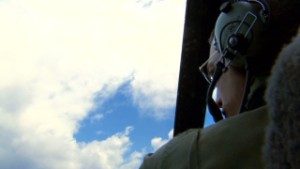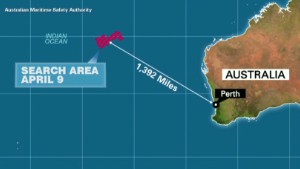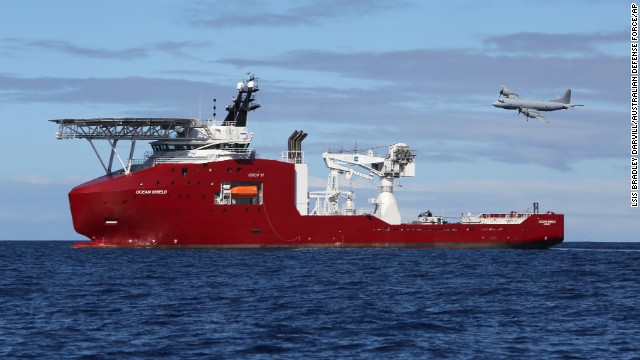Malaysia Airlines plane search: New signal possibly detected
April 10, 2014 -- Updated 2021 GMT (0421 HKT)
STORY HIGHLIGHTS
- NEW: Malaysia's Transport Ministry denies jets were scrambled
- NEW: A U.S. Navy supply ship is joining the search for the missing plane
- A new signal was detected near the Australian vessel Ocean Shield
- "Somebody in the cockpit" may have been trying to avoid detection, analyst says
(CNN) -- Investigators got new information that may help them narrow the search for Malaysia Airlines Flight 370 on Thursday as new details shed light on the doomed flight's final moments early March 8 as it flew from Kuala Lumpur toward Beijing.
A search plane has detected a possible signal -- the fifth so far -- from the locator beacons of the missing jet's so-called black boxes, the Australian agency coordinating the search announced.
The acoustic data from the possible signal, detected by an Australian air force AP-3C Orion aircraft on Thursday afternoon, were being analyzed at RAAF Base Edinburgh near Adelaide, according to a source with the Australian Defense Force. The source said the signal was detected by sonar buoys that had been deployed by the aircraft earlier.
The data show "potential of being from a man-made source," said retired Air Chief Marshal Angus Houston, the agency's chief coordinator.




A senior Malaysian government official and another source involved in the investigation divulged a number of details about the flight to CNN on Thursday, including new information about what radar detected, the last words from the cockpit and how high the plane was flying when it went off the grid.
Malaysia Airlines Flight 370 disappeared from military radar for about 120 nautical miles after it crossed back over the Malaysian Peninsula, sources say. Based on available data, this means the plane must have dipped in altitude to between 4,000 and 5,000 feet, a senior Malaysian government official and a source involved in the investigation tell CNN.
The dip could have been programmed into the computers controlling the plane as an emergency maneuver, said aviation expert David Soucie.
"The real issue here is it looks like -- more and more -- somebody in the cockpit was directing this plane and directing it away from land," said CNN aviation analyst and former National Transportation Safety Board Managing Director Peter Goelz. "And it looks as though they were doing it to avoid any kind of detection."
But former U.S. Department of Transportation Inspector General Mary Schiavo was not convinced. She said the reported dip could have occurred in response to a loss of pressure, to reach a level where pressurization was not needed and those aboard the plane would have been able to breathe without oxygen, or to get out of the way of commercial traffic, which typically flies at higher altitudes.
That would have been necessary had the plane's transponder been turned off and it lost communications. "If you don't have any communications, you need to get out of other traffic," Schiavo said.
"We still don't have any motive and any evidence of a crime yet," she said, adding that most radar can track planes at altitudes below 4,000 feet, so the plane's descent may not have indicated any attempt by whoever was controlling it to hide.
She held out hope that the black boxes hold the answers and that they will be found soon.
New flight details revealed
Malaysian sources told CNN that Flight 370's pilot, Capt. Zaharie Ahmad Shah, was the last person on the jet to speak to air-traffic controllers, telling them "Good night, Malaysian three-seven-zero."
The sources said there was nothing unusual about his voice, which betrayed no indication that he was under stress.
One of the sources, an official involved in the investigation, told CNN that police played the recording to five other Malaysia Airlines pilots who knew the pilot and copilot.
"There were no third-party voices," the source said.
The sources also told CNN that Malaysian air force search aircraft were scrambled about 8 a.m. March 8 to the South China Sea and the Strait of Malacca, soon after Malaysia Airlines reported that its plane was missing. The aircraft took off before authorities corroborated data indicating that the plane turned back westward, a senior Malaysian government official told CNN.
But the air force did not inform the Department of Civil Aviation or search and rescue operations until three days later, March 11, a source involved in the investigation told CNN.
Later Thursday, communications officials from Malaysia's Transportation Ministry denied that jets had scrambled shortly after the plane went missing, calling that claim a "false allegation."
Possible signal raises hope
The possible signal heard by a search plane was picked up through sonar buoys equipped to receive such electronic data and was detected near the Australian ship Ocean Shield, said the Joint Agency Coordination Centre.
The Australian Defense Force source said the signal detected was not at the 37.5 kHz frequency consistent with the pingers from flight data recorders but in a range that suggests strongly that it is from something that is man-made. Commodore Peter Leavy of the Royal Australian Navy said Wednesday in Perth that existing technology in RAAF P3 aircraft had been modified to allow the acoustic processor to pick up sounds in the frequency range. Using the technology in this way is experimental, according to the source.
The source said four RAAF P3 Orions have been modified with this technology, with the sonar buoys expiring and sinking about eight hours after they are deployed from the aircraft. On Wednesday, Leavy said that each P3 is capable of deploying 84 buoys, laid in a pattern or grid coordinated with the Ocean Shield.
Although Leavy said the buoys have sensors that can detect signals "at least" 1,000 feet below the surface, the source is confident that the technology has been tested at a "much deeper depth."
Crews have been narrowing the search area in the Indian Ocean.
Search areas shrinks
Up to 10 military aircraft, four civil aircraft and 13 ships were assigned to assist in Thursday's search for the Boeing 777-200ER, which was carrying 239 people when it vanished March 8 on a fight from Kuala Lumpur, Malaysia, to Beijing.



Three of the vessels -- the Ocean Shield to the north, and the British HMS Echo and Chinese Haixun 01 to the south -- were focusing under water.
Aircraft and ships spotted a number of objects during Wednesday's search but could recover only a small number, none of which appeared linked to Flight 370, the Joint Agency Coordination Centre said.
Thursday's search area was about 22,400 square miles (58,000 square kilometers), centered 1,417 miles (2,280 kilometers) northwest of Perth. That's roughly the size of West Virginia.
But the latest search area is about three-quarters of the size of the area that teams combed the day before and far smaller than what it was a few weeks ago.
Thursday's underwater search area was bracketed by the Ocean Shield at the northern end and Haixun 01 and HMS Echo at the southern end.
The Ocean Shield first picked up two sets of underwater pulses on Saturday that were of a frequency close to that used by the locator beacons. It heard nothing more until Tuesday, when it reacquired the signals twice. The four signals were within 17 miles of one another.
"I believe we are searching in the right area, but we need to visually identify wreckage before we can confirm with certainty that this is the final resting place of MH370," Houston said Wednesday.
As the search continues, a U.S. Navy supply ship will help provide supplies and fuel to the ships that are looking for the missing plane.
The USNS Cesar Chavez will help supply Australian naval ships involved in the search "in the coming days," the Navy said in a statement.
In another piece of encouraging news, authorities analyzed the signals picked up over the weekend and concluded that they probably came from specific electronic equipment rather than from marine life, which can make similar sounds.
"They believe the signals to be consistent with the specification and description of a flight data recorder," Houston said. "I'm now optimistic that we will find the aircraft or what's left of the aircraft in the not-too-distant future."
Thursday is Day 34 in the search. Time is of the essence: The batteries powering the flight recorders' locator beacons are certified to emit high-pitched signals for only 30 days after they get wet.
"The signals are getting weaker," Houston said Wednesday, "which means we're either moving away from the search area or the pinger batteries are dying."
CNN's Catherine E. Shoichet, Barbara Starr, Nic Robertson, David Molko and journalists Ivy Sam and Chan Kok Leong in Kuala Lumpur contributed to this report.
We recommend
From around the web
Community Colleges Provide Invaluable Stepping Stone for Autistic Youth(SRI International)
A Military Milestone Worth Honoring(Pinmart - Blog)
April 9, 2014 -- Updated 1535 GMT (2335 HKT)
Indra Petersons analyzes how deep the Malaysia Airlines Flight 370 wreckage could be.
April 9, 2014 -- Updated 1118 GMT (1918 HKT)
The Australian ship Ocean Shield has detected two new, weaker signals in the search for Malaysia Airlines Flight 370.
April 8, 2014 -- Updated 2214 GMT (0614 HKT)
After more than a month of searching, there's a hefty price tag that comes with the search for Malaysia Airlines Flight 370.
April 10, 2014 -- Updated 2002 GMT (0402 HKT)
Just how hard is it to find a plane at the bottom of the ocean?
April 9, 2014 -- Updated 1245 GMT (2045 HKT)
A towed pinger locator can detect pings nearly one mile in every direction.
April 7, 2014 -- Updated 2221 GMT (0621 HKT)
Almost a month after Flight 370 disappeared, searchers say pulse signals detected in the Indian Ocean provide the best hope so far.
April 7, 2014 -- Updated 1212 GMT (2012 HKT)
The pings detected by an Australian navy ship crew in the southern Indian Ocean have renewed hopes.
April 7, 2014 -- Updated 0215 GMT (1015 HKT)
Did searchers make the discovery we've all been waiting for? Here are four reasons to feel hopeful -- and six reasons why we shouldn't.
April 5, 2014 -- Updated 1123 GMT (1923 HKT)
The pinger batteries are not guaranteed to work for more than 30 days, and it's already been about a month since the plane went missing.
April 7, 2014 -- Updated 0126 GMT (0926 HKT)
If the disappearance of MH370 caused a rift in China-Malaysia relations, the two countries appear to have put it behind them.
April 2, 2014 -- Updated 1237 GMT (2037 HKT)
Jim Clancy runs down the big questions surrounding how technology and security could help prevent another airline mystery.
April 2, 2014 -- Updated 2117 GMT (0517 HKT)
After Flight 370, Malaysia Airlines is emphasizing cockpit security. We hear from aviation experts Miles O'Brien, David Soucie on CNN.
April 2, 2014 -- Updated 0413 GMT (1213 HKT)
Malaysian officials coordinating the search have been battered by criticism that they have mishandled the investigation.
April 1, 2014 -- Updated 1332 GMT (2132 HKT)
Docked at the largest naval base in Western Australia is a ship with the weight of the world resting on the shoulders of its 30-member crew.
April 4, 2014 -- Updated 1211 GMT (2011 HKT)
The mother of passenger No. 63 aboard Flight 370 is unable to come out of the shadows of her son's misdeed.
April 9, 2014 -- Updated 1323 GMT (2123 HKT)
Browse through photos taken by CNN journalists covering the missing Flight 370 story.
Most Popular
Today's five most popular stories
57°
HI 60°LO 45°
London, United KingdomWeather forecast
Home | Video | World | U.S. | Africa | Asia | Europe | Latin America | Middle East | Business | World Sport | Entertainment | Tech | Travel | iReport
Tools & Widgets | RSS | Podcasts | Blogs | CNN Mobile | My Profile | E-mail Alerts | CNN Shop | Site map | CNN Partner Hotels





































No comments:
Post a Comment